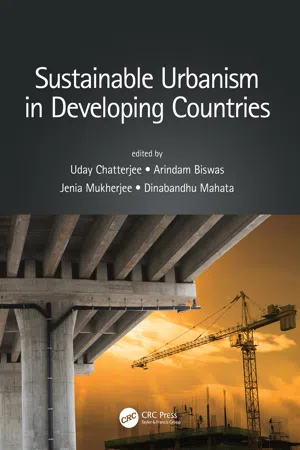
Sustainable Urbanism in Developing Countries
Uday Chatterjee, Arindam Biswas, Jenia Mukherjee, Dinabandhu Mahata, Uday Chatterjee, Arindam Biswas, Jenia Mukherjee, Dinabandhu Mahata
- 439 Seiten
- English
- ePUB (handyfreundlich)
- Über iOS und Android verfügbar
Sustainable Urbanism in Developing Countries
Uday Chatterjee, Arindam Biswas, Jenia Mukherjee, Dinabandhu Mahata, Uday Chatterjee, Arindam Biswas, Jenia Mukherjee, Dinabandhu Mahata
Über dieses Buch
The mushrooming of illegal housing on the periphery of cities is one of the main consequences of rapid urbanisation associated with social and environmental problems in the developing countries. Sustainable Urbanism in Developing Countries discusses the linkage between urbanism and sustainability and how sustainable urbanism can be implemented to overcome the problems of housing and living conditions in urban areas. Through case studies from India, Indonesia, China, etc., using advanced GIS techniques, this book analyses several planning and design criteria to solve the physical, social, and economic problems of urbanisation and refers to urban planning as an effective measure to protect and promote the cultural characteristics of specific locations in these developing countries.
FEATURES
-
- Investigates an interdisciplinary approach to urbanism, including urban ecology, ecosystem services, sustainable landscapes, and advanced geographical systems
-
- Analyses unique case studies of rapid urbanisation from a local to a national scale in countries such as India, Sri Lanka, China, Bangladesh, Malaysia, and Indonesia and their global impact
-
- Examines the use of GIS and spatial statistics in analysing urban sprawl and the massive amount of data gathered by every operational activity of municipalities
-
- Focuses on the holistic perspective of sustainable urbanism and the harmony in the human–nature relationship to achieve sustainable development
-
- Covers a wide range of issues manifested in urban areas with economic, societal, and environmental implications contributed by leading scholars from the Global South
Häufig gestellte Fragen
Information
Part I Local, Regional and Global Perspectives on Sustainable Urbanism
1 Alternative Rehabilitation Program against Agricultural Land Acquisition for New Development Projects A Case Study of New Town, Kolkata, West Bengal, India
- 1.1 Introduction
- 1.2 Study Area
- 1.3 Planning and Policies behind the Development of New Town Kolkata
- 1.3.1 Planning Stages
- 1.3.2 Assessment of Policies
- 1.4 Issues and Concerns from Land-Use Change
- 1.5 Provision of Rehabilitation under Land Legislation
- 1.5.1 Land Acquisition Act (LAA), 1894
- 1.5.2 The Right to Fair Compensation and Transparency in Land Acquisition, Rehabilitation and Resettlement (Henceforth RFCTLARR) Act, 2013
- 1.5.3 The Right to Fair Compensation and Transparency in Land Acquisition, Rehabilitation and Resettlement (Amendment) Ordinance, 2014
- 1.5.4 The Right to Fair Compensation and Transparency in Land Acquisition, Rehabilitation and Resettlement (Amendment) Ordinance, 2015
- 1.6 Existing Rehabilitation Program
- 1.7 Proposal for Alternative Rehabilitation Program
- 1.7.1 Mango Orchard in Vacant Land
- 1.7.2 Floriculture in Open Space
- 1.8 Conclusion
- Acknowledgments
- References
1.1 Introduction
The most widespread changes in the extent of land-use categories in the EU between 1990 and 2006 were cropland decline (∼136,660 km2), followed by expansion of grazing land (∼75,670 km2), and expansion of forest areas (∼70,630 km2). The least common conversion among broad land-use categories was urban expansion (∼16,820 km2). … At the European scale, these area changes translate into moderate land-conversion rates in the agricultural sector between 1990 and 2006, ranging from −13.4% for permanent crops to +6.5% for meadows and pastures, while urban areas expanded by approximately 21%.(Kuemmerle et al. 2016)
Inhaltsverzeichnis
- Cover Page
- Half Title Page
- Title Page
- Copyright Page
- Dedication
- Contents
- Foreword
- Preface
- Acknowledgments
- Editors
- Contributors
- Part I Local, Regional and Global Perspectives on Sustainable Urbanism
- Part II Urban Planning, Innovation and Urban Resilience for Sustainable Development
- Part III Environmental Management and Ecosystem Services
- Part IV A Multidimensional Approach to Urban Ecology, Space, Society and Sustainability
- Index